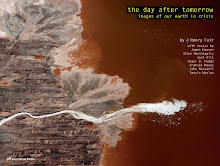One of my current projects is photographing the coasts of the USA.
As climate change impacts become more severe, the coasts will be increasingly affected, from heavy storm damage with tremendous economic impacts, to large-scale amelioration projects which will change the look of littoral areas. We could even witness a societal decision to retreat from the coasts and let them resume their buffering function.
The Great Lakes are a vital part of our coastal perimeter, and conditions are in flux there like everywhere.
While climate change is expected to cause increased storms and rising ocean waters, the effects on The Great Lakes is less well known, though increasing and increasingly erratic storm activity is a universal reality for any region in this age.Paradoxically, while oceans elevate due to climate change, the lakes shrink due to reduced precipitation (especially snowfall) and increased evaporation. The Great Lakes fishing industry, valued at $7 billion per year, is under threat from numerous sources: invasive species, climate change induced water temperature change, and industry.
LightHawk pilot extraordinaire Bob Keller, with his usual skill, finesse, and insight, volunteered to fly this project. We documented extensive development on the coast, industries that are polluting the water, killing the fish, and contributing to climate change. Some of the highlights:
-The most problematic nuclear plant in the country, with numerous leaks and accidents.
-The most expensive nuclear plant in the country. So expensive, they stopped construction when they were nearly finished.
-A refinery taking tar sands oil, then selling their waste as fuel to the power plant next door, which is the largest killer of fish on the Great Lakes (an estimated value of $30 million worth of fish annually).
The Great Lakes are the seat of the "rust belt;" that stretch of industry that propelled the USA in the era when manufacturing was dominant in the country, and environmental regulation was weak or non-existent.
Much of this has disappeared, but much remains, perpetuating a legacy of pollution and climate change.
Among the points of interest:
-Seven coal-fired power plants emitting a total of: 43,000,000 tons of CO2, and over 2,300 pounds of mercury.
-The site of America's failed attempt at nuclear waste reprocessing, one of the most toxic sites in the country.
-Abandoned power plants, and paper mills.
-A train locomotive factory that is scaling back production due to reduced demand for coal, a result of hydro-fracking.
-A harbor with material transfer stations being dredged and dumping tremendous amounts of silt out into the lake.
The Great Lakes are a tremendous source of food and fresh water, two resources which are becoming increasingly rare in our day. We might do well to put efforts toward protecting them.
29 July 2013
24 June 2013
Privacy
Arriving at my destination after a recent international flight, I opened my suitcase to find it had been ransacked. In it was a nice note from the TSA which said: "You have no privacy. We can open your luggage, listen to your phone calls, read your mail and all electronic communications, even kill you if we deem you a threat to our agenda." Actually, that's not what it said. It assured me that my bag had been pillaged for my protection, and that the government was here to help.
Meanwhile, one of the biggest current news stories of the day is the revelation that the NSA (an agency of which most Americans were unaware) has been snooping wholesale into all of our electronic communications. Incredibly, when queried, most people respond that they have nothing to hide, which misses the point entirely. Most if not all of the people that were blacklisted in the McCarthy Era had nothing to hide, yet their lives were ruined. J. Edgar Hoover used personal information to blackmail many people, including presidents. If you have nothing to hide, is it ok that we watch you undress in the bathroom? After all, we must verify that you have nothing to hide, since you cannot be trusted. And I'm sorry that we had to listen to that personal phone call in which you were talking to your paramour, but it's in the name of national security. What's that you say? You don't want genetically modified products in your food? Sounds like you are an enemy of the state. You object to the polluting of the Gulf Of Mexico by BP? Arrest that man.
Power corrupts, as has been proven again and again. After the world trade centers were destroyed (watch this doc from Colorado Public TV) we allowed an unprecedented intrusion into our lives in the name of security. Since then, as we are engrossed in our smart devices, the government and the corporations that own it, have increasingly invaded your house, your communications, and your health, with little objection from the public. As our world moves daily closer to the reality laid out by George Orwell, that lame defense, "it's ok, because I have nothing to hide," will soon become, like Winston Smith, "I have one corner in my house free from the eyes of Big Brother, in which I can go to read the banned books about genetic modification or the children that are maimed around the world in our name (Vietnam, Iraq, Afghanistan)."
On the first Earth Day in 1970, masses of people were in the streets protesting. Last year, most people did not know it was an important day, and the few announcements of it were made by companies trying to sell "green" products.
Privacy matters. Not because we have something to hide, but because it is our right. If we relinquish that right, then, when the government oversteps, (McCarthy Era, Nazi Germany) then it is our obligation to set it back on track. That will not be possible if they have already incarcerated the dissenters.
Meanwhile, one of the biggest current news stories of the day is the revelation that the NSA (an agency of which most Americans were unaware) has been snooping wholesale into all of our electronic communications. Incredibly, when queried, most people respond that they have nothing to hide, which misses the point entirely. Most if not all of the people that were blacklisted in the McCarthy Era had nothing to hide, yet their lives were ruined. J. Edgar Hoover used personal information to blackmail many people, including presidents. If you have nothing to hide, is it ok that we watch you undress in the bathroom? After all, we must verify that you have nothing to hide, since you cannot be trusted. And I'm sorry that we had to listen to that personal phone call in which you were talking to your paramour, but it's in the name of national security. What's that you say? You don't want genetically modified products in your food? Sounds like you are an enemy of the state. You object to the polluting of the Gulf Of Mexico by BP? Arrest that man.
Power corrupts, as has been proven again and again. After the world trade centers were destroyed (watch this doc from Colorado Public TV) we allowed an unprecedented intrusion into our lives in the name of security. Since then, as we are engrossed in our smart devices, the government and the corporations that own it, have increasingly invaded your house, your communications, and your health, with little objection from the public. As our world moves daily closer to the reality laid out by George Orwell, that lame defense, "it's ok, because I have nothing to hide," will soon become, like Winston Smith, "I have one corner in my house free from the eyes of Big Brother, in which I can go to read the banned books about genetic modification or the children that are maimed around the world in our name (Vietnam, Iraq, Afghanistan)."
On the first Earth Day in 1970, masses of people were in the streets protesting. Last year, most people did not know it was an important day, and the few announcements of it were made by companies trying to sell "green" products.
Privacy matters. Not because we have something to hide, but because it is our right. If we relinquish that right, then, when the government oversteps, (McCarthy Era, Nazi Germany) then it is our obligation to set it back on track. That will not be possible if they have already incarcerated the dissenters.
Labels:
Big Brother,
Earth Day,
George Orwell,
J Edgar Hoover,
McCarthy Era,
privacy,
TSA
03 May 2013
The Gibbes Vote
Sometimes it takes a while for me to get the picture.
When the Gibbes Museum in Charleston announced a "People's Choice" exhibit, I happily completed their questionnaire about favorite artists and what not, and basically ignored their further requests for me to drum up the troops via the various "social" interfaces that seem to be the rage.
Only at the last minute, the day before Easter, did I finally read the email and understand that I needed to call the hearty to arms to vote for inclusion of my piece in the exhibit.
Mind you, I was on a little agriturismo, eating oranges and drinking Portuguese wine. In spite of the intermittent internet, I valiantly put down my drink (we were on to port by this point), and logged-on to the one and the other and begged my friends and connections to perform two clicks and vote for my piece (“Pig Shit” (alternately titled "Bacon" in politer circles)).
And it worked, proving that you can get your friends to cast a few clicks on your behalf on short notice. Or, maybe that your friends don't have any other lives than to be looking at social media the night before Easter.
Ironically, if one posts an urgent call for action about an arcane but vital environmental bill, we are much less likely to act.
Somehow the information overload makes me less able to respond and act on weighty citizenship issues, and more in search of divertimenti. Ironic that we all seem so preoccupied in our digital world, when the physical world cries out for our ministrations.
When the Gibbes Museum in Charleston announced a "People's Choice" exhibit, I happily completed their questionnaire about favorite artists and what not, and basically ignored their further requests for me to drum up the troops via the various "social" interfaces that seem to be the rage.
Only at the last minute, the day before Easter, did I finally read the email and understand that I needed to call the hearty to arms to vote for inclusion of my piece in the exhibit.
Mind you, I was on a little agriturismo, eating oranges and drinking Portuguese wine. In spite of the intermittent internet, I valiantly put down my drink (we were on to port by this point), and logged-on to the one and the other and begged my friends and connections to perform two clicks and vote for my piece (“Pig Shit” (alternately titled "Bacon" in politer circles)).
And it worked, proving that you can get your friends to cast a few clicks on your behalf on short notice. Or, maybe that your friends don't have any other lives than to be looking at social media the night before Easter.
Ironically, if one posts an urgent call for action about an arcane but vital environmental bill, we are much less likely to act.
Somehow the information overload makes me less able to respond and act on weighty citizenship issues, and more in search of divertimenti. Ironic that we all seem so preoccupied in our digital world, when the physical world cries out for our ministrations.
Labels:
art,
Charleston,
environment,
exhibit,
Gibbes Museum,
photography,
political,
Portugal,
South Carolina
12 April 2013
The Gas Bubble
Market bubbles come and go, but they all have things in common: a few people get rich, a lot of people get taken, and a mess is left for the taxpayers to clean up. To understand the hydro-fracking bubble, there are some things one must know: each well only produces a little gas (and exhausts relatively quickly), reserves were significantly overstated at the beginning of the game, and most important: Wall Street is very invested and wants its money out.
The devastating environmental effects of the process are well documented, and not the subject of this essay (water depletion, water pollution, habitat and farmland destruction, and significant climate change impacts).
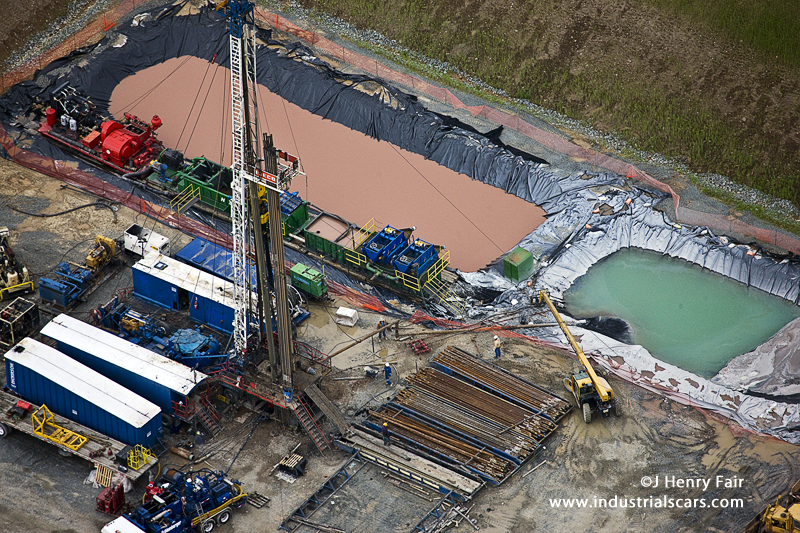 Hydro-fracking drill sites during drilling process with drilling slurry containment pond
Hydro-fracking drill sites during drilling process with drilling slurry containment pond
The process of fracturing rock to create a cavity in a thin layer of shale, deep under ground, to extract the gas trapped in cells there does not create a large pocket. So, only a small amount of gas is produced, and the well is exhausted quickly. Given the low volume of gas produced by a single well, sustained supply depends on the production of many, many wells, which means many leases must be signed with landowners. As the gas rush caught on, there was a big push by gas drillers to sign as many leases as possible, as these "reserves" increased the company's value, and thus its stock price. When those leases began to come due, they had to be exercised, or else they would expire, thus increasing the market glut.
In any resource extraction rush, the easily obtained reserves are the first to be taken, and as they dwindle, more difficult and expensive assets are pursued until such time as extraction cost plus profit exceeds market cost, at which point extraction ceases.
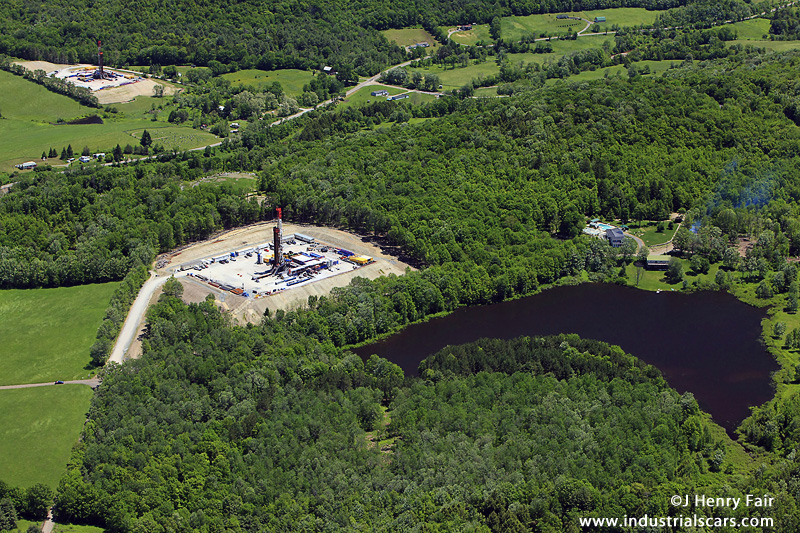 Hydro-fracking site with drill rig next to pond, cut out of forest
Hydro-fracking site with drill rig next to pond, cut out of forest
The Energy Information Agency has predicted that the USA will shift much its energy production to natural gas in the coming years, based on the imagined plentiful supply, and clean combustion characteristics of this fuel. With the sudden oversupply brought on by the hydro-fracking rush, the price of natural gas has plummeted with numerous consequences. Most alarmingly, the bottom has dropped from the sustainable energy markets, as gas has became cheaper than wind or solar, which have already become competitive with oil and coal. Given the low price, and the EIA predictions of plenty in the future, many industries have placed significant investments on gas-fueled technologies. Last year, the USGS significantly lowered its estimate of recoverable gas in the East Coast shale deposits to at least one twentieth of their previous estimates, upon which the gas bubble was based. But as the money was already invested, there is little discussion of this.
The oversupply of gas in the USA has driven domestic prices to about a fifth of the worldwide average, a situation that can only be temporary. Last week, a pump on a gas pipeline supplying Britain from the continent failed, causing a 50% spike in wholesale gas prices. Though it was not revealed at the time, Britain, suffering an unusually cold winter, was down to a two day supply of gas. This week it was announced that a US gas company had signed a contract to supply hydro-fracked gas to Britain, starting in 2018, in the form of liquid natural gas, via tankers loaded in Louisiana.
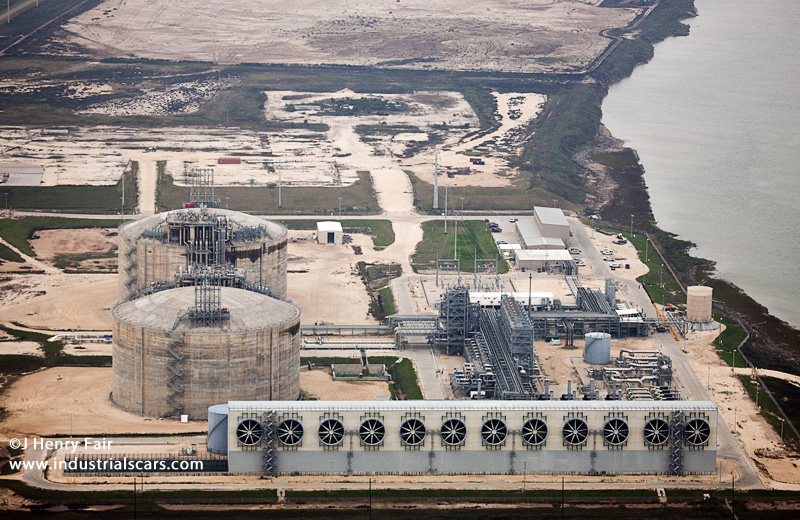 Liquid natural gas compression terminal
Liquid natural gas compression terminal
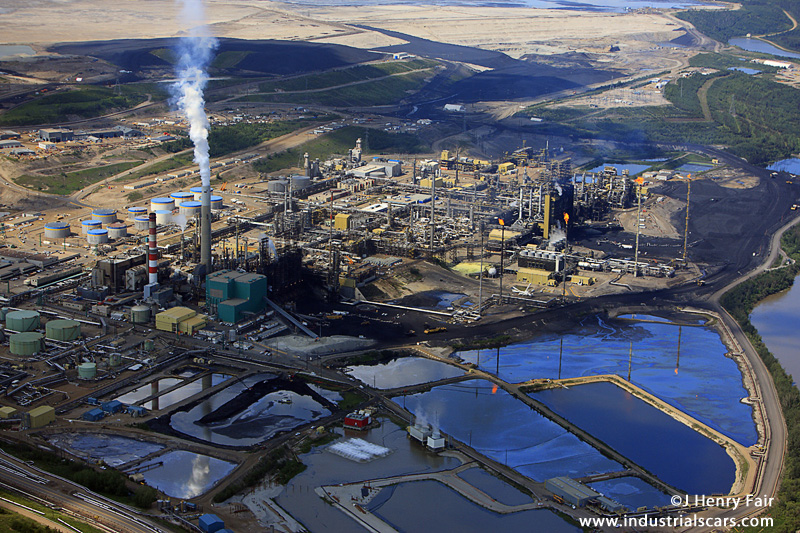 Oil sands upgrader in Alberta
Oil sands upgrader in Alberta
In the last few years, the EPA has finally enacted air quality regulations that will force electricity utilities to either retire or upgrade the most dangerous coal fired power plants. Many of these utilities, taking into account the projections of future gas supplies, and current USA market price of gas, are converting their electricity production to natural gas. In 2000, the USA produced 51% of its electricity with coal, and 16% with gas; in 2010 the ratio was 44.5% and 24.1%, and the trend continues.
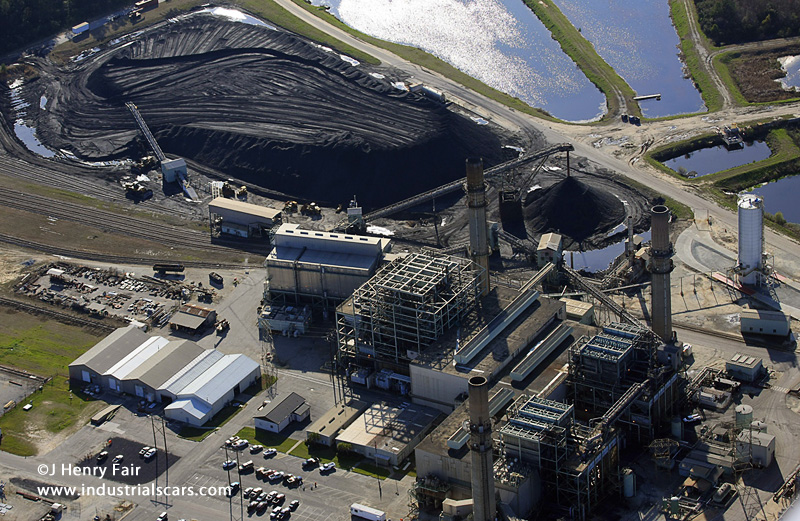 Coal fired power plant in SC, soon to be retired
Coal fired power plant in SC, soon to be retired
So let's add up all of these facts and draw a few conclusions:
-tremendously overstated supplies
-an overstatement upon which bankers make large investments
-increasingly expensive and difficult reserves remain for extraction
-commitments in place to sell gas overseas in markets with higher prices
-numerous domestic industries (especially electric utilities) implementing technologies to utilize the erroneously projected plentiful, cheap gas supplies
-coal powered electrical generation converted to natural gas to avoid the expense of adding pollution controls
-Wall Street wants its money back before the bubble bursts, so the pressure is on the gas companies to keep drilling wells and producing gas to pay the interest on the loans.
So where will that leave us, the average citizens in the USA?
The first thing that will affect all of us will be a tremendous spike in electricity prices in the next few years as US natural gas prices equalize with world market prices, which will have risen from current levels due to the voracious demand of Europe, Asia, the tar sands, and diminishing world supplies. More importantly, we will be faced with depleted and polluted groundwater, and tremendously degraded farmland here at home as we rushed to keep the bubble inflated.
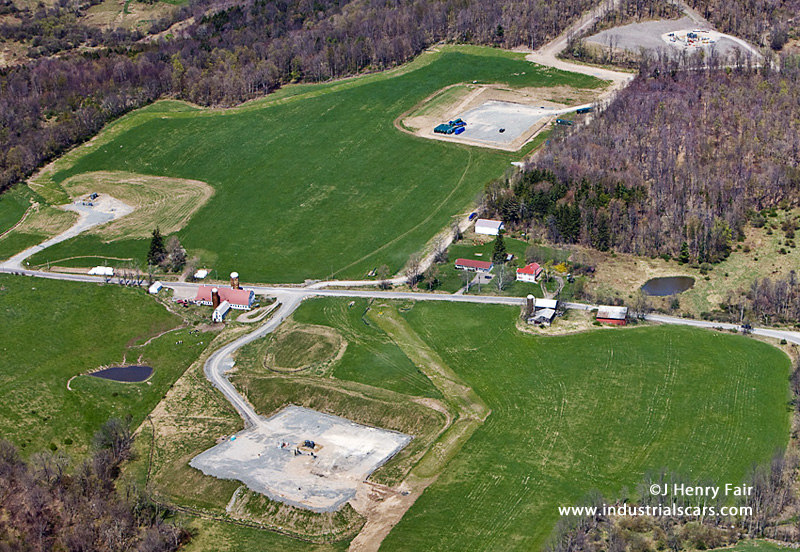 Farm with four completed hydro-fracking well pads
Farm with four completed hydro-fracking well pads
The devastating environmental effects of the process are well documented, and not the subject of this essay (water depletion, water pollution, habitat and farmland destruction, and significant climate change impacts).
 Hydro-fracking drill sites during drilling process with drilling slurry containment pond
Hydro-fracking drill sites during drilling process with drilling slurry containment pondThe process of fracturing rock to create a cavity in a thin layer of shale, deep under ground, to extract the gas trapped in cells there does not create a large pocket. So, only a small amount of gas is produced, and the well is exhausted quickly. Given the low volume of gas produced by a single well, sustained supply depends on the production of many, many wells, which means many leases must be signed with landowners. As the gas rush caught on, there was a big push by gas drillers to sign as many leases as possible, as these "reserves" increased the company's value, and thus its stock price. When those leases began to come due, they had to be exercised, or else they would expire, thus increasing the market glut.
In any resource extraction rush, the easily obtained reserves are the first to be taken, and as they dwindle, more difficult and expensive assets are pursued until such time as extraction cost plus profit exceeds market cost, at which point extraction ceases.
 Hydro-fracking site with drill rig next to pond, cut out of forest
Hydro-fracking site with drill rig next to pond, cut out of forestThe Energy Information Agency has predicted that the USA will shift much its energy production to natural gas in the coming years, based on the imagined plentiful supply, and clean combustion characteristics of this fuel. With the sudden oversupply brought on by the hydro-fracking rush, the price of natural gas has plummeted with numerous consequences. Most alarmingly, the bottom has dropped from the sustainable energy markets, as gas has became cheaper than wind or solar, which have already become competitive with oil and coal. Given the low price, and the EIA predictions of plenty in the future, many industries have placed significant investments on gas-fueled technologies. Last year, the USGS significantly lowered its estimate of recoverable gas in the East Coast shale deposits to at least one twentieth of their previous estimates, upon which the gas bubble was based. But as the money was already invested, there is little discussion of this.
The oversupply of gas in the USA has driven domestic prices to about a fifth of the worldwide average, a situation that can only be temporary. Last week, a pump on a gas pipeline supplying Britain from the continent failed, causing a 50% spike in wholesale gas prices. Though it was not revealed at the time, Britain, suffering an unusually cold winter, was down to a two day supply of gas. This week it was announced that a US gas company had signed a contract to supply hydro-fracked gas to Britain, starting in 2018, in the form of liquid natural gas, via tankers loaded in Louisiana.
 Liquid natural gas compression terminal
Liquid natural gas compression terminal Oil sands upgrader in Alberta
Oil sands upgrader in AlbertaIn the last few years, the EPA has finally enacted air quality regulations that will force electricity utilities to either retire or upgrade the most dangerous coal fired power plants. Many of these utilities, taking into account the projections of future gas supplies, and current USA market price of gas, are converting their electricity production to natural gas. In 2000, the USA produced 51% of its electricity with coal, and 16% with gas; in 2010 the ratio was 44.5% and 24.1%, and the trend continues.
 Coal fired power plant in SC, soon to be retired
Coal fired power plant in SC, soon to be retiredSo let's add up all of these facts and draw a few conclusions:
-tremendously overstated supplies
-an overstatement upon which bankers make large investments
-increasingly expensive and difficult reserves remain for extraction
-commitments in place to sell gas overseas in markets with higher prices
-numerous domestic industries (especially electric utilities) implementing technologies to utilize the erroneously projected plentiful, cheap gas supplies
-coal powered electrical generation converted to natural gas to avoid the expense of adding pollution controls
-Wall Street wants its money back before the bubble bursts, so the pressure is on the gas companies to keep drilling wells and producing gas to pay the interest on the loans.
So where will that leave us, the average citizens in the USA?
The first thing that will affect all of us will be a tremendous spike in electricity prices in the next few years as US natural gas prices equalize with world market prices, which will have risen from current levels due to the voracious demand of Europe, Asia, the tar sands, and diminishing world supplies. More importantly, we will be faced with depleted and polluted groundwater, and tremendously degraded farmland here at home as we rushed to keep the bubble inflated.
 Farm with four completed hydro-fracking well pads
Farm with four completed hydro-fracking well pads22 February 2013
Texas Coast
Texas is certainly one of the most enigmatic states in the USA, with a contradiction jumping up immediately for most any assertion. The petrochemical industry calls Houston its home, and bestows upon it many gifts and afflictions from fine museums and wealth to poverty and pollution.
Though I have photographed the Houston harbor petrochemical complex several times, there is much else to see along the coast which has eluded me. Southwings pilot, Tom Hutchings, evinced a similar interest and volunteered to make the trek down south along the coast to Mexico.
I booked a ticket to fly to Houston and meet him, but then the weather man spoke badly about the coming days. This is always the tough gamble: bet on the prediction and change all of the schedules, or go when it's the most convenient. This time I chose the former, changed my ticket, and as always the front rolled through a day after the man predicted. Generally a storm front is followed by clear weather, which is ideal for shooting, though often also a bumpy ride–not to be attempted by the weak of stomach. But it didn't work that way this time; the front was weak and came through late, so we did not have that bluebird day or two. When you throw dice with God, you take what you get and be glad you got out of the game at all, so off we went.
Our goals were grand, so we decided to do it in two days: Houston Harbor to Galveston and south to Freeport the first day, picking it up there the next day (after waiting out the weather) and going down to Corpus Christi, then even further south to the Mexican Border (had to indulge the pilot's whim on that). The Houston Harbor is fascinating (for those who are fascinated by the infrastructure that drives our world (40% of the refining capacity in the USA is along the Gulf of Mexico coast, and much of the petrochemical industry)). In the Harbor itself we photographed a few sites for environmental groups that were pursuing lawsuits, and otherwise pursued the current directions of the Industrial Scars project, which is recently tending to more mechanical abstracts than the fluid dynamics of the last show. Tom later told me, as this was the day before the front blew through, that the air was so thick that it was like a magic carpet ride to fly the plane, and of course I felt it as well.

Tom and I have flown together many times, and it's always a three-way contest of wills on these missions: him versus me, with the air traffic controllers trumping both. After looking at the BP refinery in Texas City, the site of so many disasters, we moved to Galveston, where I spotted several cruise ships docked in the bay. These things are tremendous environmental pigs, not to mention sociological fascinations, so I requested a flyover. Tom averred that there was nothing interesting there, and we were moving on, an outcome I was not about to accept. We started our collaboration on the BP Deepwater disaster, and our relationship is similar to that of combat veterans. I spotted a drill rig across the bay in the Haliburton dry docks and said, "Oh look, isn't that the Q4000 over there in drydock?" (the rig that did all the heavy lifting at the BP Deepwater site), and of course he could not help but fly-over to have a look, which took us right over the cruise ships, and they were as interesting as I has suspected. The rig in drydock was The Uncle John, a deepwater pipe-laying machine.
Over the coastline, we were immediately struck by the tremendous amount of construction right to the water's edge, and a six foot sea wall "protecting" Galveston City proper. Having just come through Hurricane Sandy, where so much coastal construction was destroyed, the topic of building near the water looms large in the national dialog. As we face the specter of ocean rise, wise planning would dictate a significant setback from the water. And in this era of budget constraints, taxpayer financed flood insurance is nothing short of a boondoggle. The houses along this coast are an invitation to the next hurricane, and one amusement park in particular reminded me of nothing if not a ball teed up to be swatted away.
Further southwest, we ventured to Freeport, home of one of the most poisonous chemical/plastics plants in the country, making nice things that insulate your house and surround you every day. Ironically, some of the most toxic things are the least photogenic, so aside from a few shots for documentation, we have not much to show. One other interesting thing in Freeport confronted us: two giant tanks connected by a complex pattern of pipes to a large array of fans. We flew around and around trying to ascertain the nature of the beast until it hit me: a compressor station for liquefying natural gas. Oh, the works of man. Thus ended the first day.

Though I have photographed the Houston harbor petrochemical complex several times, there is much else to see along the coast which has eluded me. Southwings pilot, Tom Hutchings, evinced a similar interest and volunteered to make the trek down south along the coast to Mexico.
I booked a ticket to fly to Houston and meet him, but then the weather man spoke badly about the coming days. This is always the tough gamble: bet on the prediction and change all of the schedules, or go when it's the most convenient. This time I chose the former, changed my ticket, and as always the front rolled through a day after the man predicted. Generally a storm front is followed by clear weather, which is ideal for shooting, though often also a bumpy ride–not to be attempted by the weak of stomach. But it didn't work that way this time; the front was weak and came through late, so we did not have that bluebird day or two. When you throw dice with God, you take what you get and be glad you got out of the game at all, so off we went.

Our goals were grand, so we decided to do it in two days: Houston Harbor to Galveston and south to Freeport the first day, picking it up there the next day (after waiting out the weather) and going down to Corpus Christi, then even further south to the Mexican Border (had to indulge the pilot's whim on that). The Houston Harbor is fascinating (for those who are fascinated by the infrastructure that drives our world (40% of the refining capacity in the USA is along the Gulf of Mexico coast, and much of the petrochemical industry)). In the Harbor itself we photographed a few sites for environmental groups that were pursuing lawsuits, and otherwise pursued the current directions of the Industrial Scars project, which is recently tending to more mechanical abstracts than the fluid dynamics of the last show. Tom later told me, as this was the day before the front blew through, that the air was so thick that it was like a magic carpet ride to fly the plane, and of course I felt it as well.


Tom and I have flown together many times, and it's always a three-way contest of wills on these missions: him versus me, with the air traffic controllers trumping both. After looking at the BP refinery in Texas City, the site of so many disasters, we moved to Galveston, where I spotted several cruise ships docked in the bay. These things are tremendous environmental pigs, not to mention sociological fascinations, so I requested a flyover. Tom averred that there was nothing interesting there, and we were moving on, an outcome I was not about to accept. We started our collaboration on the BP Deepwater disaster, and our relationship is similar to that of combat veterans. I spotted a drill rig across the bay in the Haliburton dry docks and said, "Oh look, isn't that the Q4000 over there in drydock?" (the rig that did all the heavy lifting at the BP Deepwater site), and of course he could not help but fly-over to have a look, which took us right over the cruise ships, and they were as interesting as I has suspected. The rig in drydock was The Uncle John, a deepwater pipe-laying machine.

Over the coastline, we were immediately struck by the tremendous amount of construction right to the water's edge, and a six foot sea wall "protecting" Galveston City proper. Having just come through Hurricane Sandy, where so much coastal construction was destroyed, the topic of building near the water looms large in the national dialog. As we face the specter of ocean rise, wise planning would dictate a significant setback from the water. And in this era of budget constraints, taxpayer financed flood insurance is nothing short of a boondoggle. The houses along this coast are an invitation to the next hurricane, and one amusement park in particular reminded me of nothing if not a ball teed up to be swatted away.

Further southwest, we ventured to Freeport, home of one of the most poisonous chemical/plastics plants in the country, making nice things that insulate your house and surround you every day. Ironically, some of the most toxic things are the least photogenic, so aside from a few shots for documentation, we have not much to show. One other interesting thing in Freeport confronted us: two giant tanks connected by a complex pattern of pipes to a large array of fans. We flew around and around trying to ascertain the nature of the beast until it hit me: a compressor station for liquefying natural gas. Oh, the works of man. Thus ended the first day.

Labels:
BP,
climate change,
cruise ship,
Deepwater,
Galveston,
Gulf of Mexico,
Houston,
SouthWings,
Texas
02 January 2013
Vegetarian in Berlin
I've been around the world, but never to a restaurant with the entrance in an industrial loading dock. You really must look to find Cookies Cream in Berlin, but it's worth it.
There is no sign on the street, and one must walk back into an alley by the Comic Opera Berlin. Just when you think Mackie Messer is about to jump out and do something rash to your person, you spot a large antique chandelier hanging in the loading dock, the incongruity of which give a bit of hope. An unmarked steel door with a buzzer allows you entrance, at which point the decor resembles a downtown NYC club.
This is a fine vegetarian restaurant, really nice helpful staff, and great food. We had, for appetizers: the pumpkin soup (out of this world), Mozzarella di Bufala with figs and toasted walnuts (quite good, though once you have had the real thing in Italy, everything else is just a reminder of what could be). Main course was Parmesan potatoes filled with peppers and goat cheese (fine) and kohlrabi with beluga lentils (hmmm good)
We opted for the cookies and cream for desert (vanilla ice cream with chocolate cookies with bits of olive (quite good).
Coming from the USA, where plates are gigantic, the tendency to smaller portions at first site leaves one disappointed, but you don't go away hungry, and it's certainly much healthier to eat less.
I highly recommend this place, and will return.
There is no sign on the street, and one must walk back into an alley by the Comic Opera Berlin. Just when you think Mackie Messer is about to jump out and do something rash to your person, you spot a large antique chandelier hanging in the loading dock, the incongruity of which give a bit of hope. An unmarked steel door with a buzzer allows you entrance, at which point the decor resembles a downtown NYC club.
This is a fine vegetarian restaurant, really nice helpful staff, and great food. We had, for appetizers: the pumpkin soup (out of this world), Mozzarella di Bufala with figs and toasted walnuts (quite good, though once you have had the real thing in Italy, everything else is just a reminder of what could be). Main course was Parmesan potatoes filled with peppers and goat cheese (fine) and kohlrabi with beluga lentils (hmmm good)
We opted for the cookies and cream for desert (vanilla ice cream with chocolate cookies with bits of olive (quite good).
Coming from the USA, where plates are gigantic, the tendency to smaller portions at first site leaves one disappointed, but you don't go away hungry, and it's certainly much healthier to eat less.
I highly recommend this place, and will return.
Subscribe to:
Posts (Atom)







